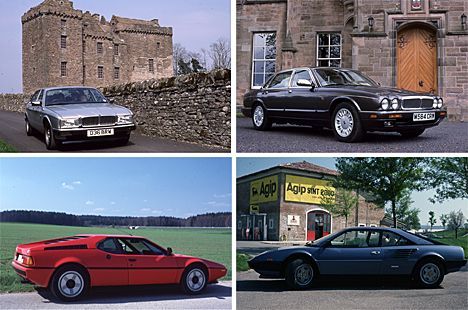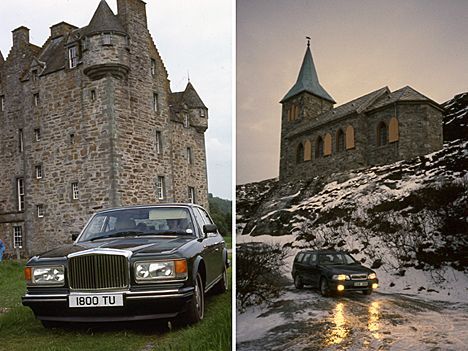Article
Europe by Car: Advice to Save You Time, Hassle and Money
Author(s):
A reader and his spouse would like to tour Europe by car this summer and asks our travel columnist for suggestions. Here are his tips for proceeding on a fun and sometimes challenging trip.
Photography by the author.
Q: We fancy a driving vacation in Europe and we wondered how realistic an idea it might be. Suggestions? A: You don’t say where you want to go or how much time you can take but let me guess, maybe 10 days, and the destination classic places or countries. I assume you are not young and inexperienced, nor elderly and, in addition, lacking driving skills -- so let’s proceed on this fun trip!
This is fun for me because your query reminds me of a long trip I made in May 1981, driving from Rome to Paris for Autoweek magazine. I drove a Fiat in Rome, a Lancia to Munich, a BMW to Paris and a Peugeot diesel around France. I doubt that much has changed in the last 30 years because, essentially, when you drive amongst the locals you’ll find the driving is simply a feature of the national personality, and that really hasn’t changed all that much. I’ve been back a lot since the ‘80s.

Top left clockwise: Two Jaguars in Scotland; a Ferrari Mondial in Modena, Italy; a BMW M1 in Munich, Germany.
To answer your question, your idea is indeed realistic, but there are some things you might want to do first. Go to your local AAA office and get an International Driving Permit. Strictly speaking it’s not necessary, but it’s cheap and may be useful.
Next, you want to look into how car-rental contracts overseas are treated on your credit card terms -- call to speak to a representative if it’s not clear. Spend time on this: You’ll save money if some extra rental expenses, such as insurance, are covered by your card. Check out the European map section at the AAA office and/or visit a bookstore to obtain a current driving map written in English. This can be important: Nancy and I drove around the Costa Brava, in the northeast corner of Spain, about four years ago with an inadequate map, and poorly signed roads and country lanes. It was a bit distracting!

Top left clockwise: A BMW 5 series at Neuschwanstein Castle in Bavaria; a little Fiat at the Medieval Medical School in Padua, Italy; a Peugeot 505 Turbo Diesel at Le Mans, France; and a Lancia in the Italian Alps.
Do an online search for car rentals to compare the prices of U.S.-based rentals with local ones. We’ve had good results with AutoEurope. You may feel you want a big car with automatic transmission and great luggage capabilities, but there are three problems with that: the rental is more expensive; parking is difficult for large autos in major European cities; and the cost of gas for a big car is going to blow your socks off. I often used to borrow a cousin’s Jaguar in Britain and I recall once paying 85 pounds (or roughly $137) to fill the two tanks a few years ago. (Americans are so lucky with our relatively low U.S. gas prices, we should be ashamed to complain.)
For another viewpoint I spoke to Nico Zenner, the president of the long-established Brendan Vacations. He has driven all over Europe and presides over a travel company that arranges well-researched, self-drive vacations initially in Ireland but now all over. Brendan can arrange itineraries, hotels and car rentals. All you have to do is the driving, but you can even arrange a driver. Brendan Vacations is a unit of the Los Angeles-based Travel Corp., which has more than 125 staff members.

A Bentley in Scotland; a Volvo in the Arctic Circle where Finland, Norway and Russia meet.
So what does Zenner say?
“First: There are some cities you shouldn’t drive in, such as Rome or Paris,” he says. Why not? Because there is too much traffic there, the traffic rules for those cities are complicated and -- if you are driving -- you don’t see so much.”
Zenner’s second point is to warn that you may need to adjust your speed. “By that I mean you may have to speed up and drive faster because, for example, in Germany there is no speed limit,” he says. I smile because I remember being given an exciting BMW M1 for a day’s use on the Autobahn. The BMW publicist in Munich took a moment to tell me there was no speed limit, but if I drove faster than the equivalent of 140 miles an hour, the BMW car insurance would be invalidated and I’d be on my own if I had an accident. Hmm.

Nico Zenner, president of Brendan Vacations, says he likes to drive in a decent car in German, but in Switzerland, where he wants to look at the scenery, he’d rather have a simple vehicle, such as a “Smart Car.”
Zenner also notes: “Traffic rules are not the same as those in the United States,” he says, “You cannot pass on the right. My advice might be that you get into the slow lane and stay out of harm’s way.” He says when he finds a car in front of him not moving over but continuing to occupy the fast lane (which is actually intended for passing) he knows he’s behind a non-European driver.
His third point is a simple one: “Be prepared for sticker shock: gas is very expensive."
Eric Anderson, MD, who lives in San Diego, is one of the resident travel & cruise columnists for Physician's Money Digest. Eric a retired MD, and the one-time president of the New Hampshire Academy of Family Practice, Eric is the only physician in the American Society of Travel Writers. He has also written five books, the last called The Man Who Cried Orange: Stories from a Doctor's Life.




